
Raffles House, where Sir Stamford Raffles built the first official government mansion in 1822
Signal flags here communicated with shipmasters and merchants during Singapore’s early trading days.
23 February Singapore
In the 14th century, the palace of ancient Singapura
stood atop a prominent hill that overlooked the harbor. The royal family moved
to Melaka on peninsular Malaysia in 1400 and the site remained vacant until Sir
Stamford Raffles, founder of modern Singapore, arrived in 1819 and the British
soon built Fort Canning. In 1936 the British constructed an underground bunker
‘Battlebox’ at the fort, and it was here on 15 February 1942 that leaders made
the difficult decision to surrender to the invading Japanese. Now it’s a museum
www.battlebox.com.sg/ but open only on guided tours. I had made a
reservation for S$20 the day before, then arrived early to admire the gardens,
fort remnants, and heritage buildings, though skyscrapers and trees now block
views of the harbor and sea that the site once commanded.

Raffles House, where Sir Stamford Raffles built the first official
government mansion in 1822
Signal flags here communicated with shipmasters and
merchants during Singapore’s early trading days.

Flame of the forest or royal poinciana (Delonix regia) is native to
Madagascar.
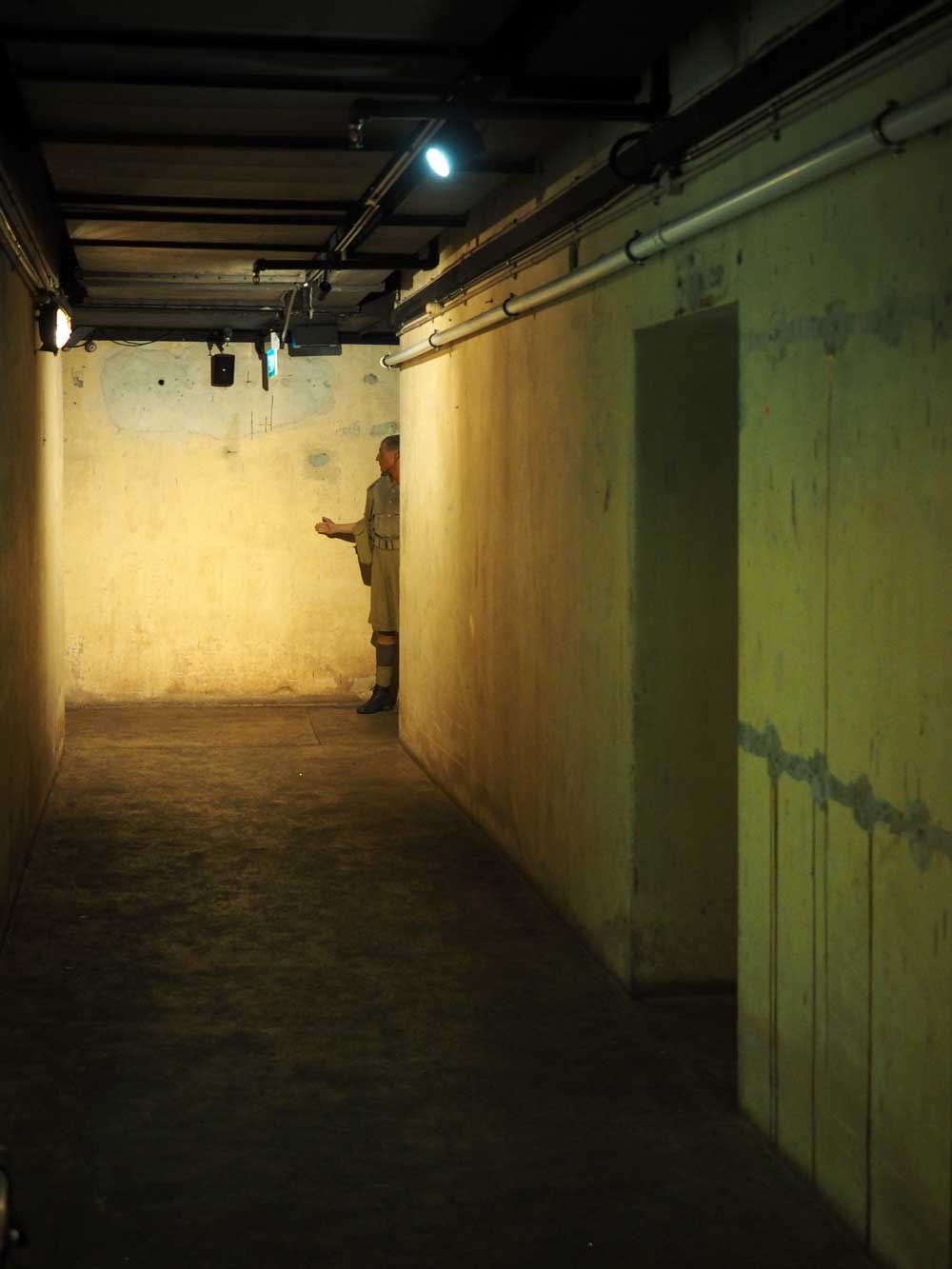
A peek into the Battlebox
The tour uses exhibits and short videos to tell the story of what Winston
Churchill called “the worst disaster and largest capitulation in British
history.” Although the British had a large troop presence to protect the Malayan
Peninsula and Singapore, they lacked the necessary airpower, ships, and tanks.
The Japanese had a vastly superior air force along with better tactics and
equipment—such as tanks and, of course, bicycles—that forced the British,
Australian, and Indian troops to retreat to Singapore, abandoning their food and
other supplies along the way. After the tour I walked over to Little India and a
thali at Komala Vilas Vegetarian Restaurant.
24 February Singapore
I
first visited St. Andrew’s Cathedral, funded by Scottish merchants and built by
Indian convicts. Although completed in 1838, it had to be rebuilt in 1862 after
lightening damage.
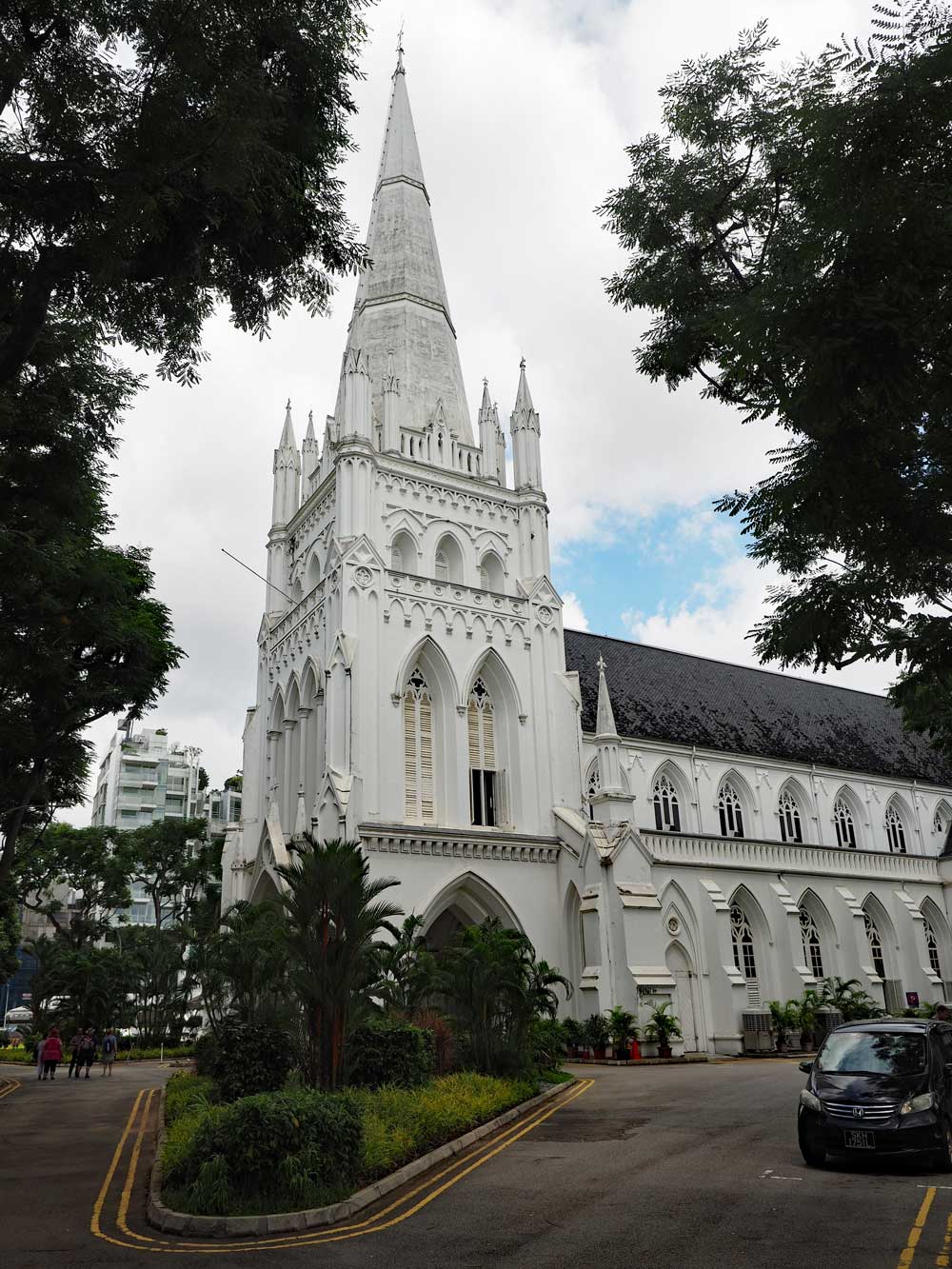
St. Andrew’s Cathedral is a fine example of English Gothic architecture.

Stained glass adds color to the plain interior.
The beautifully restored neo-classical 1905 Victoria Theatre & Concert Hall www.vtvch.com/ offered a free ‘Organ: Francais’ concert at 12:30 p.m. today, for which I had reserved online. A French organist played mainly works of French and Belgian composers along with a couple by Bach on a grand Klais pipe organ consisting of 2,012 pipes.
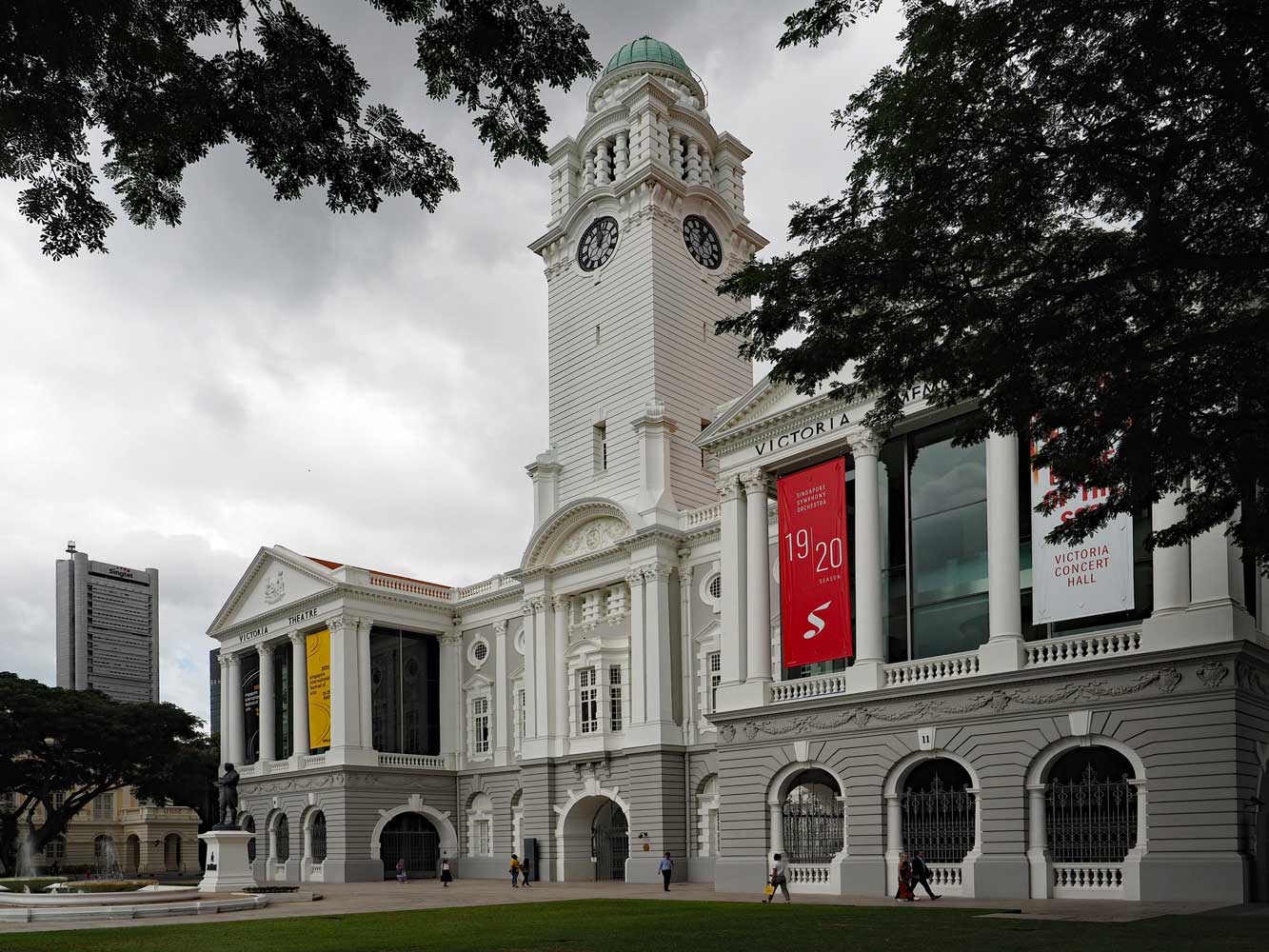
Victoria Theatre & Concert Hall
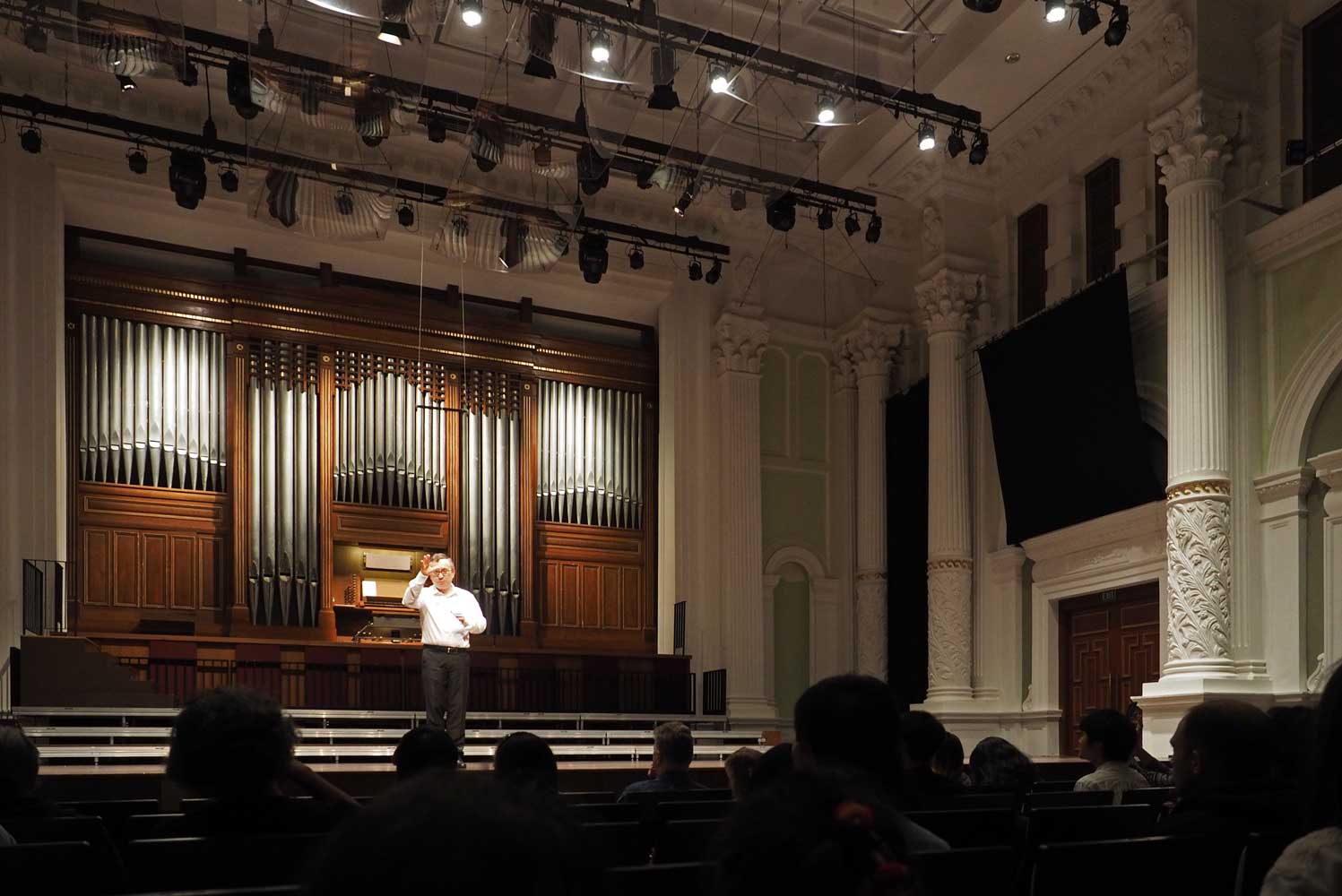
The organist gave background for each piece he played.
After the enjoyable concert I headed to nearby National Gallery Singapore to resume my wanderings among the paintings and sculptures. A senior and Singapore Airlines discounts brought the entry fee from $S15 down to S$11.25. Today I focused on the Southeast Asia galleries which followed developments from early European artists to local styles that paralleled independence movements, cultural changes, and finally wacky contemporary art. Even with five hours, I still didn’t quite finish experiencing everything! Singapore has been increasingly concerned about the coronavirus (COVID-19) and I had to get my temperature scanned before entry at both the concert hall and museum. Bits of rain fell during the day, so I was glad to be indoors, but had stopped by evening when I strolled over to Little India for a South Indian thali at Ananda Bhavan Restaurant.

The library under the rotunda of the old supreme court building is still
open.

La Banca (1876), by Filipino artist Félix Resurrección Hidalgo, is bathed in a soft golden
light,
reflecting the colonial impression of the Philippines as a peaceful
paradise.

Market at Marmot (1940) by French artist Louis Rollet
The place name in the
title may be a misspelling of ‘Memot,’ a district in eastern Cambodia,
which may
explain the seemingly Cambodian and Vietnamese figures in the scene.

Tin Mine (Ipoh) (c. 1953) by Georgette Chen
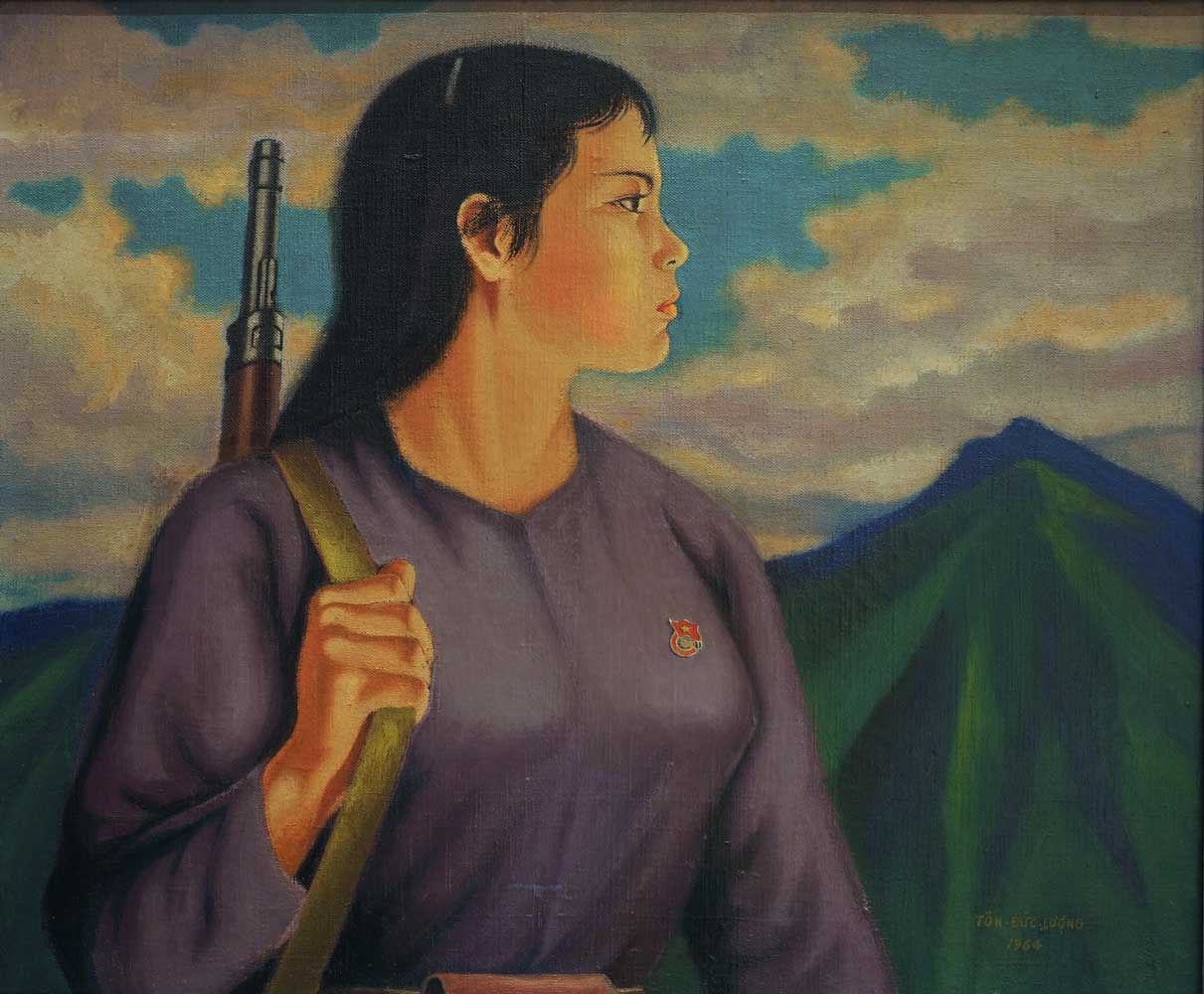
[Not titled] (A Militia Woman) (1964) by Vietnamese artist Ton Duc Luong,
who also designed the badge of the Vietnam Labor Youth Union worn by the woman.
The heroic image was likely painted to inspire young people in the fight against
the South Vietnam Army.
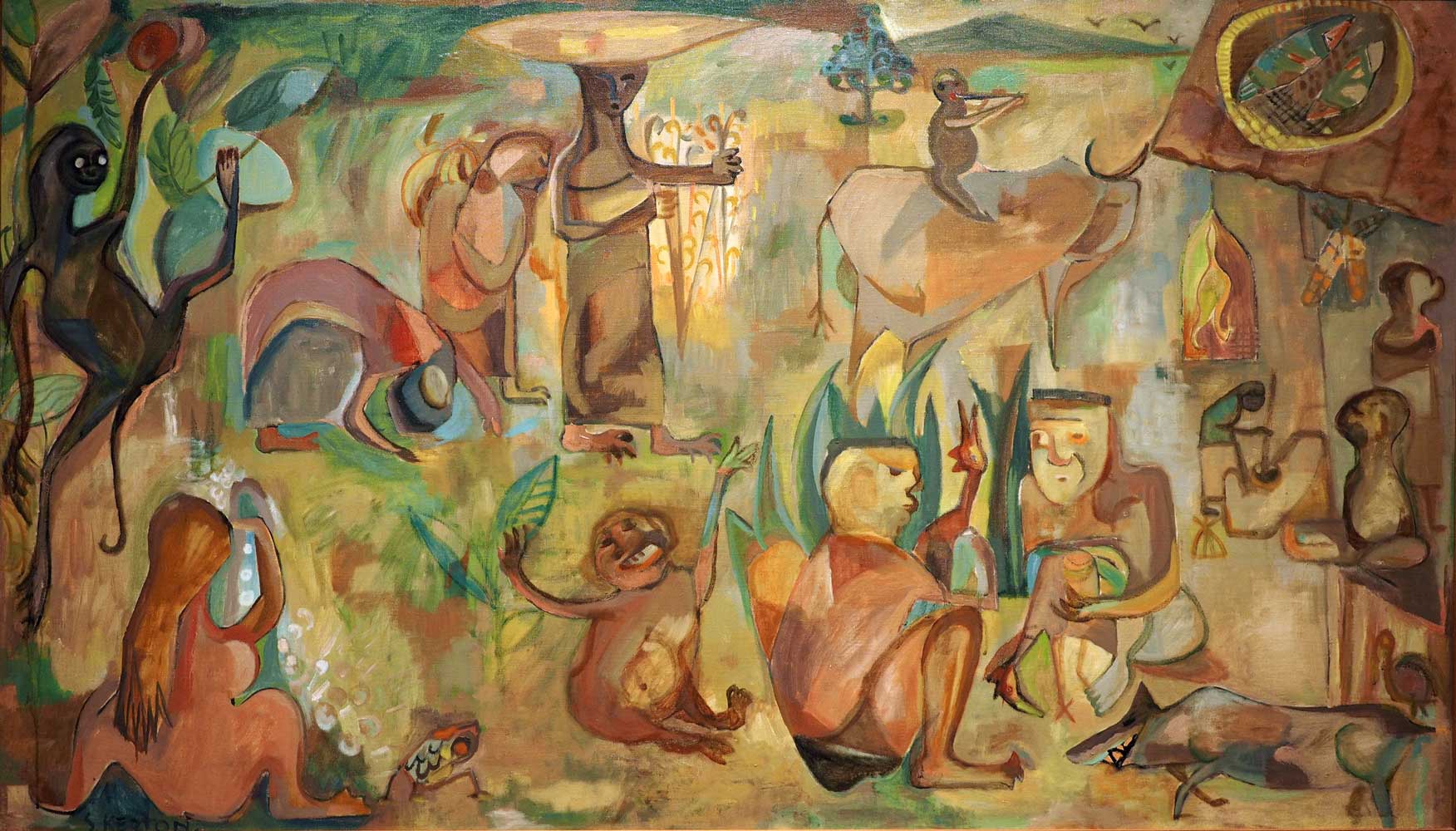
Kehidupan di Kampung (Village Life) (c. 1960s) by Indonesian artist Sudjana
Kerton
The artist spent many years overseas in New York City and other
locations, then returned to Indonesia and built a studio in the hills on the
edge of Bandung in West Java.
I met him, his wife, and daughter there in the
early 1980s.

A Non-Visual Art Situation (1978) by Malaysian artist Redza Piyadasa
25 February Singapore
On a partly cloudy day I went back to nature at the
Singapore Botanic Gardens www.nparks.gov.sg/sbg. Although only about
five kilometers north of where I was staying, public transport took a roundabout
route, so I grabbed a Grab taxi (S$8) for a quicker ride and entered at the
Tanglin Gate in the southeast corner. The huge and diverse gardens, begun here
in 1859, display more than 10,000 species of flora over 82 hectares. Although a
major Singapore attraction, admission to the main gardens is free; hours run 5
a.m.-midnight (8:30 a.m.-7 p.m. for the National Orchid Garden). I started at
the Heritage Museum with exhibits about early development of rubber trees and
discoveries in breeding orchids. At a nearby building I could look through
windows to see test tubes and flasks whirling about for the garden’s plant
research. I particularly liked the Rainforest Trail, which loops past giant
trees in a type of forest that once covered most of Singapore. I meandered my
way through the gardens, which stretch 2.5 kilometers from south to north
entrances, with detours to the many attractions. Unsurprisingly lots of birds
enjoy the foliage, and I saw jungle fowl (chickens?), herons, waders,
woodpeckers, hummingbirds, and pigeons. At Eco Lake in the north, I swung back
to the south and made my way to the famous National Orchid Garden with over
1,000 species and 2,000 hybrids on display; there’s a S$5 (S$1 senior; children
free) admission here and well worth it. Short trails loop past outdoor displays
of colorful blooms in countless hues and sizes. Lastly I walked through exhibits
of ginger plants, desert flora, bonsai, heritage trees, sundial garden, and
along the shore of Swan Lake to Marsh Garden. Lots of locals had come out for a
walk or run in the late afternoon, now that the blazing sun had cooled down.
Outside the Tanglin Gate, I caught a bus east along Orchard Road with its many
upscale shopping centers to an MRT subway for a short hop to Little India and a
South Indian thali at Komala Vilas Vegetarian Restaurant.
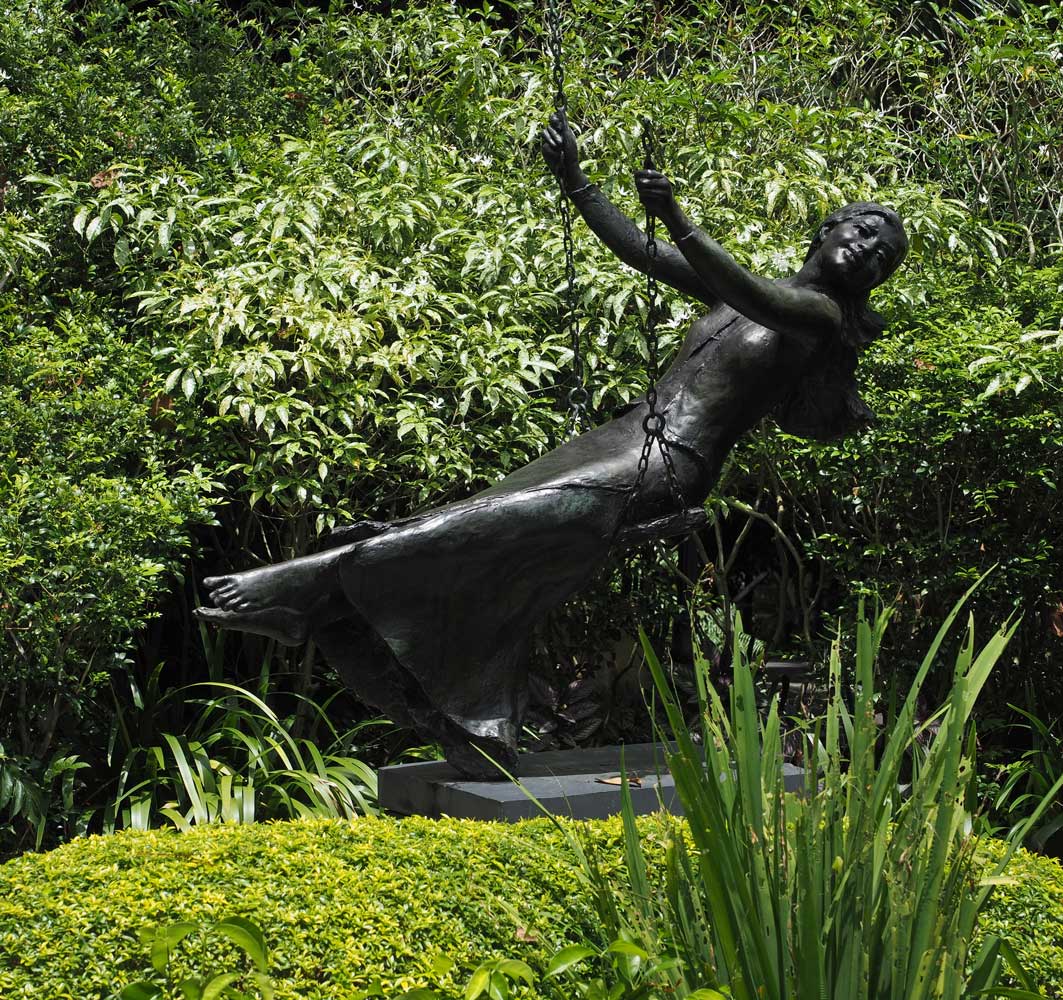
Girl on a Swing (1984) by Sydney Harpley R.A.
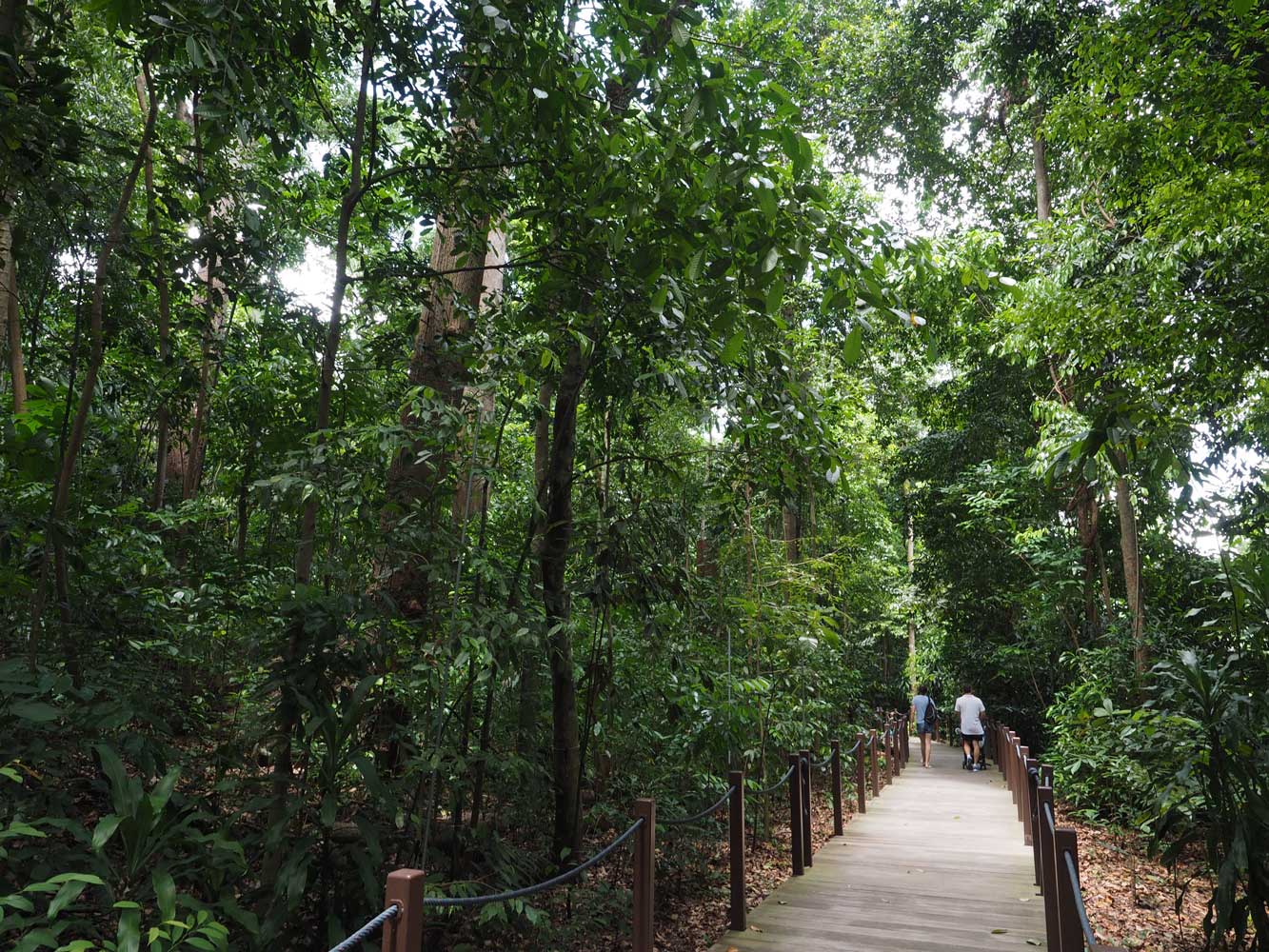
Strolling through the Rain Forest Area

Strange leaves in the Rain Forest Area catch a bit of sunlight.
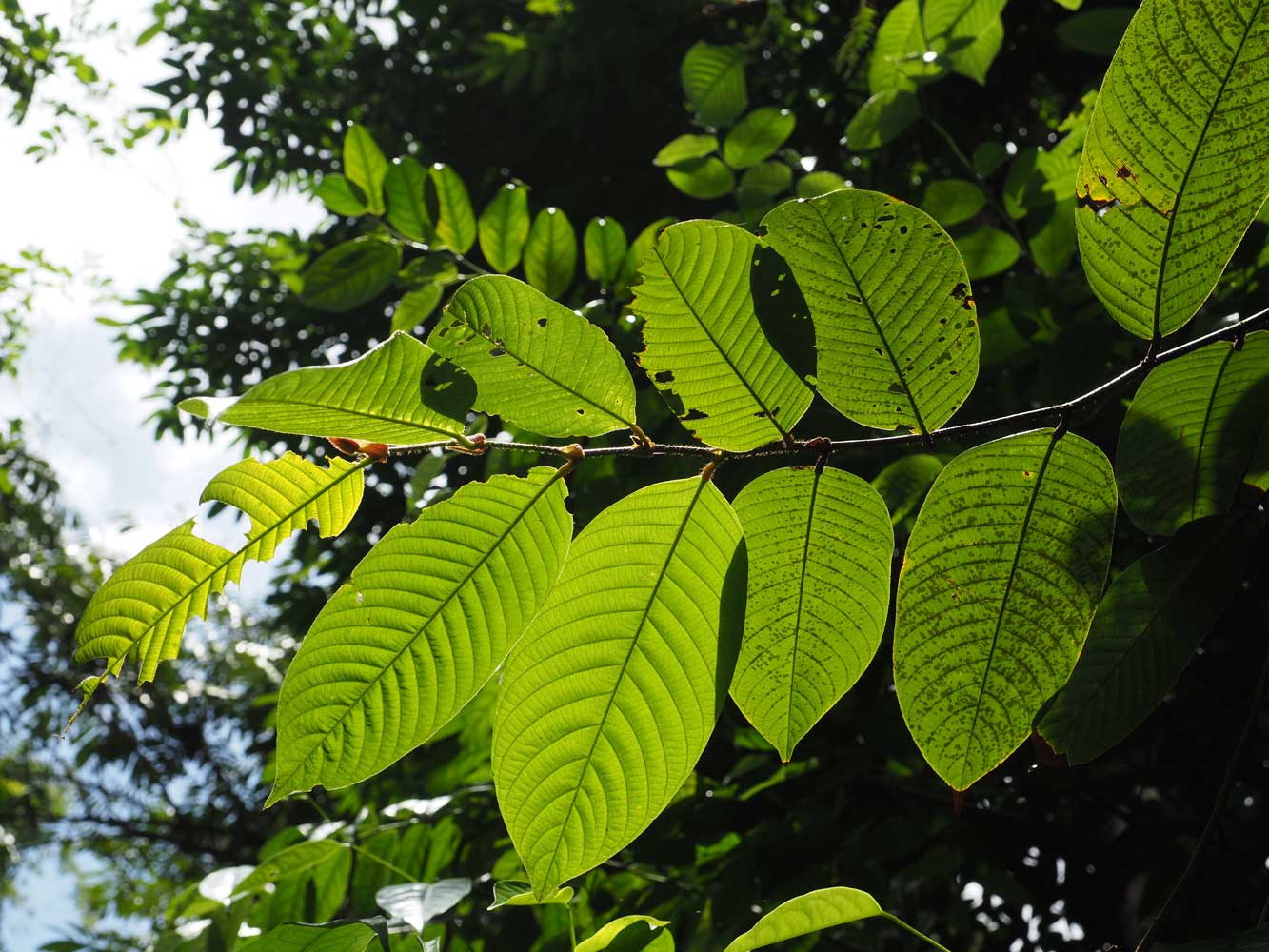
Some of the countless shades of green in the Rain Forest Area

Palm Valley displays about 800 palms of 100 genera and 200 species!
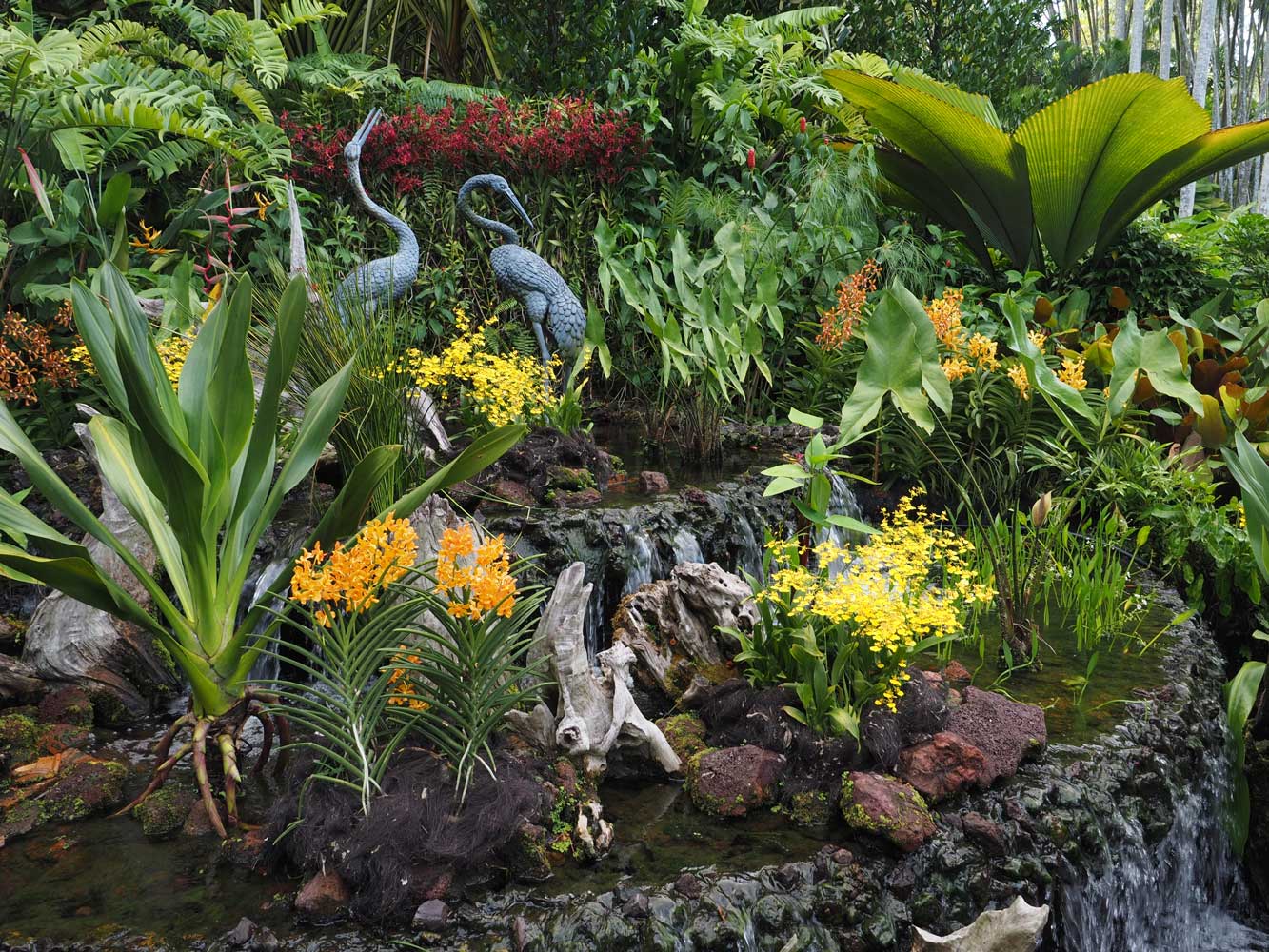
This planting with a pair of crane sculptures marks the entrance to the National
Orchid Garden.
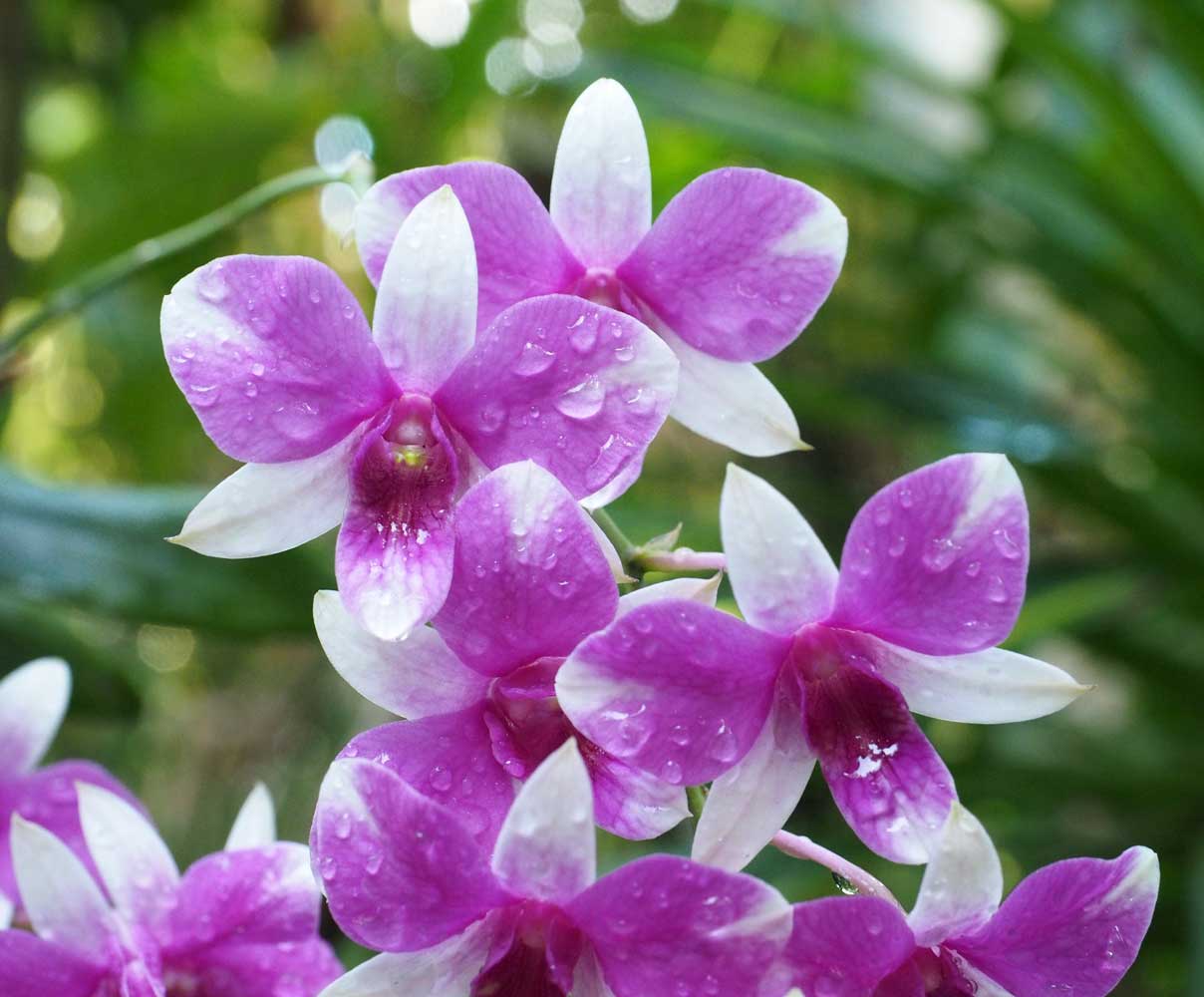
Vibrant hues in the National Orchid Garden

A cluster of whites in the National Orchid Garden
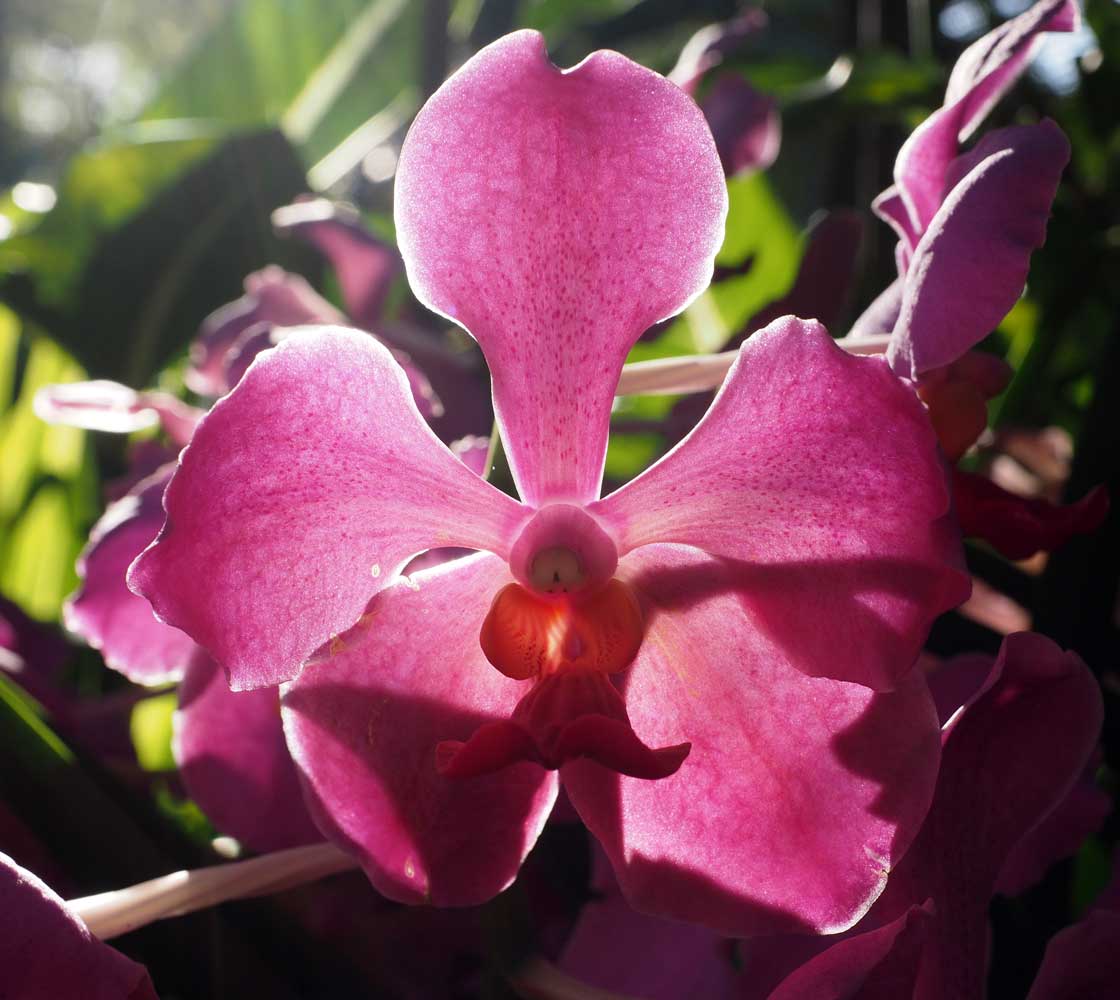
A backlit beauty in the National Orchid Garden
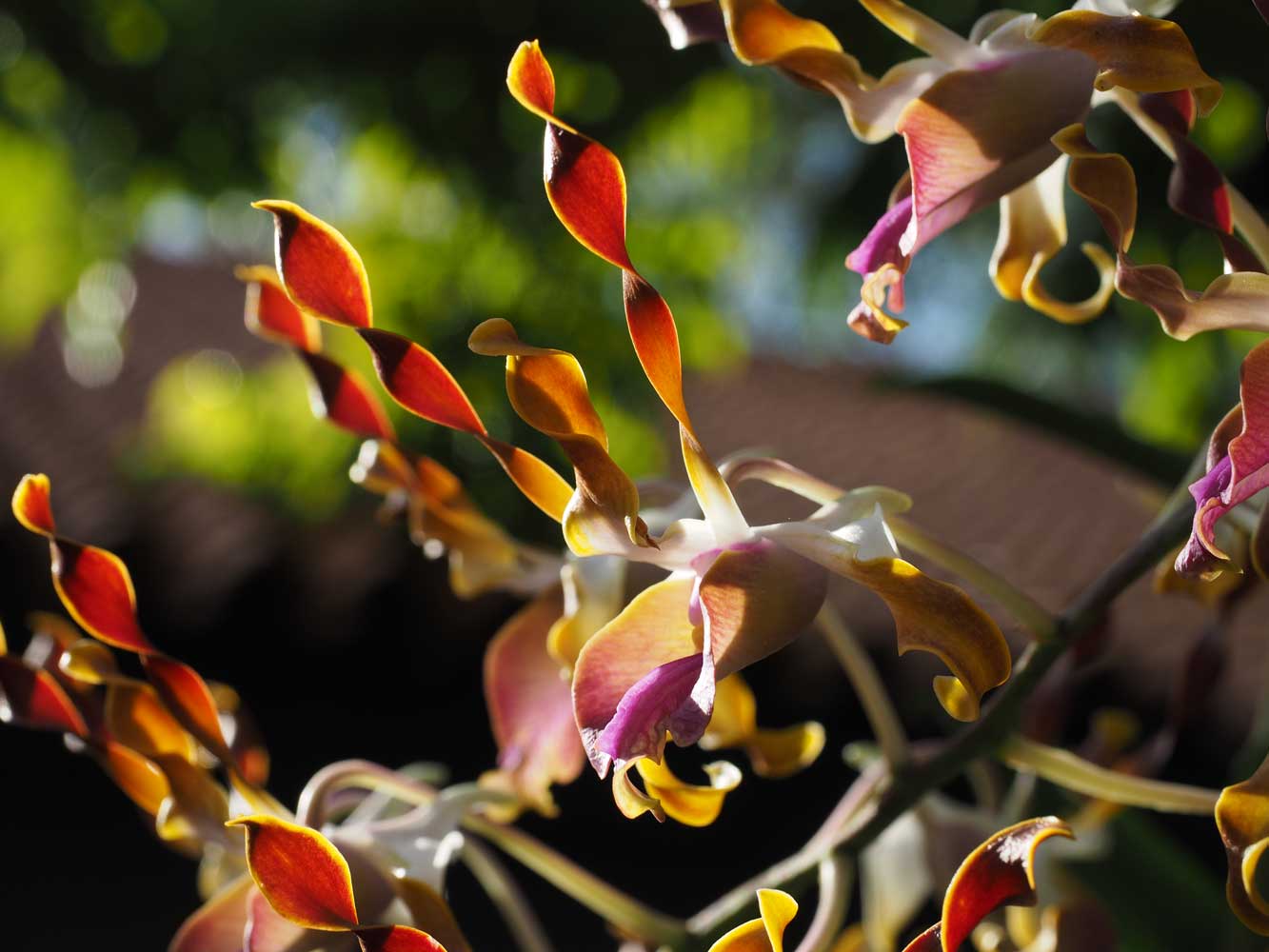
Dendrobium Iriana Jokowi honors Indonesian president Joko Widodo and his
wife Iriana Joko Widodo on the occasion of their visit to the National Orchid
Garden in 2015.
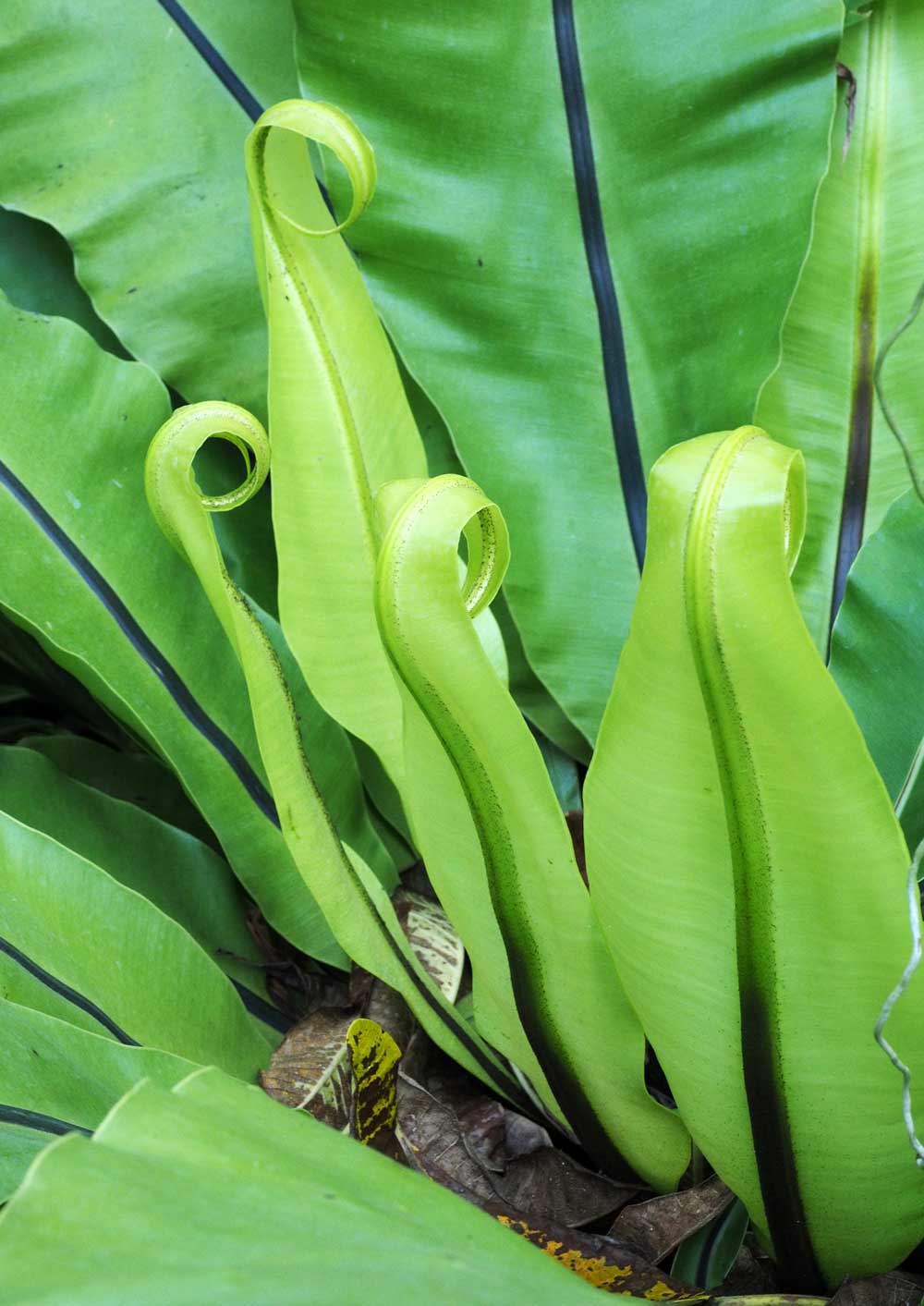
Youthful fern fronds in the National Orchid Garden
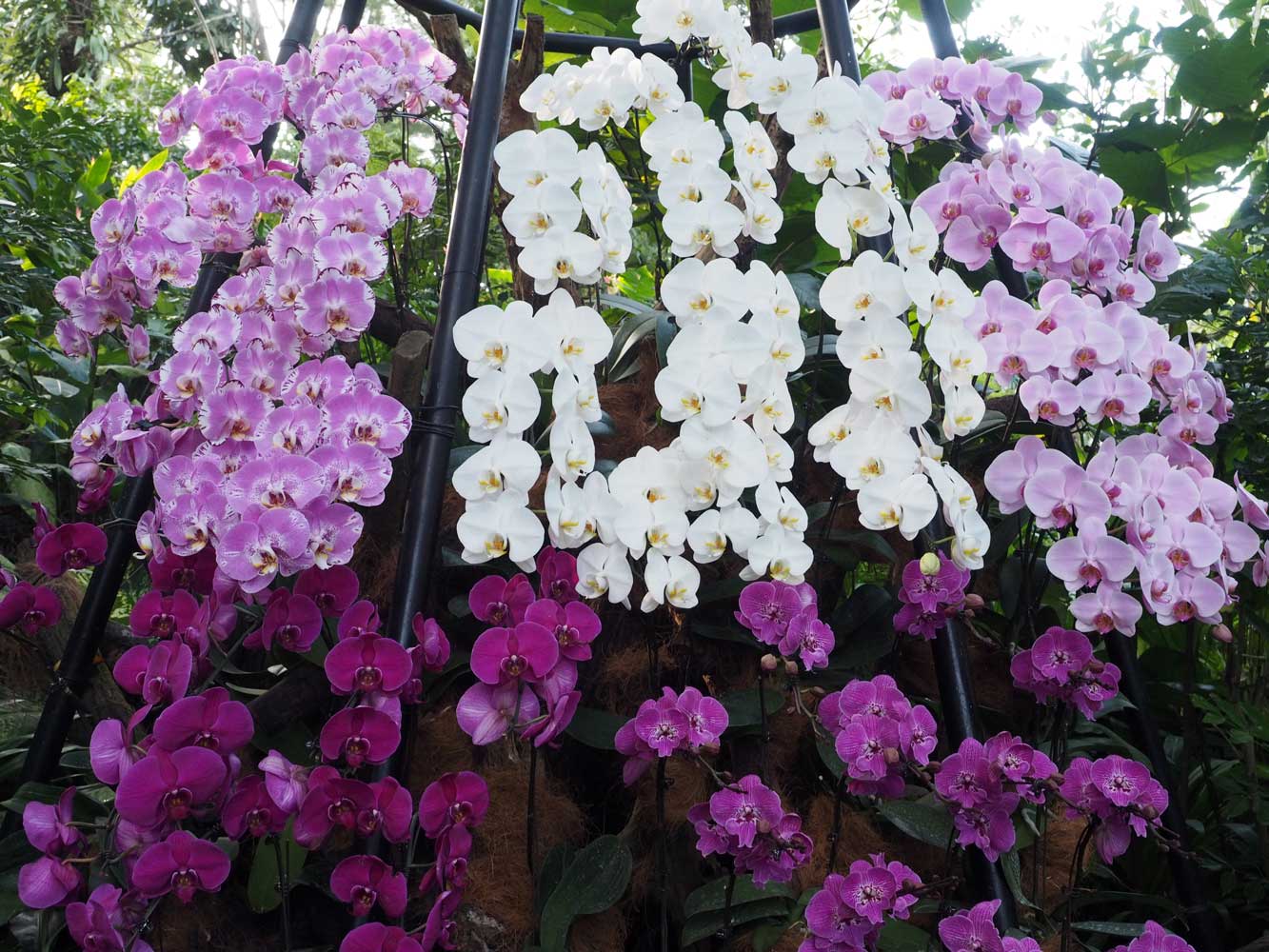
A display in the National Orchid Garden

Verdant arches in the National Orchid Garden
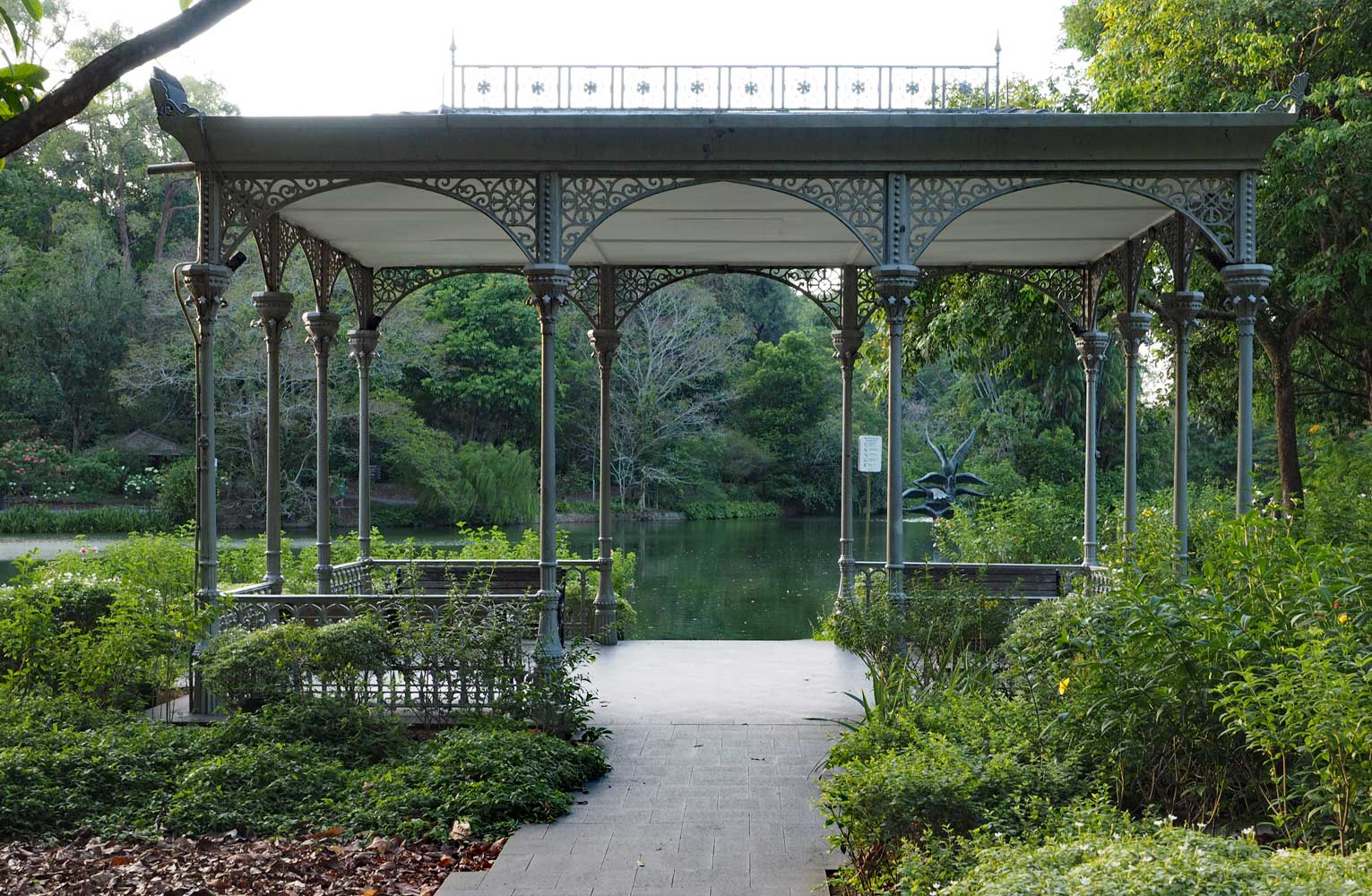
Swan Lake Gazebo, a Victorian cast-iron garden shelter, dates back to the
1850s.
26 February
Singapore
A pleasant mostly sunny day dawned, then I set to work on laundry
and bringing the journal text up to date. In the early afternoon I headed to
Chinatown, just 20 minutes away by bus, and dived into narrow lanes lined with
beautifully restored two- or three-story shophouses. It’s very touristy with
innumerable souvenir shops. I found my way to the huge multi-story Buddhist
Tooth Relic Temple www.btrts.org.sg/
and entered the main Maitreya Hall where two monks led chanting for the
congregation. One hundred statues of the Buddha—all in different poses—line the
walls, and one hundred dragons dance above them. Around back in the smaller
Universal Wisdom Hall, a statue of Avalokitesvara on a lotus throne ‘floats’ on
sea waves with a phoenix at each corner. Embroidered Chinese characters spell
out the Heart Sutra behind the statue. Traditional lanterns glow from the
ceiling. When I asked the way to the upper floors to visit the shrine of the
famed tooth, a museum, and the rooftop garden, a security official told me they
had been closed due to concerns of the coronavirus (COVID-19).

Strolling through Chinatown
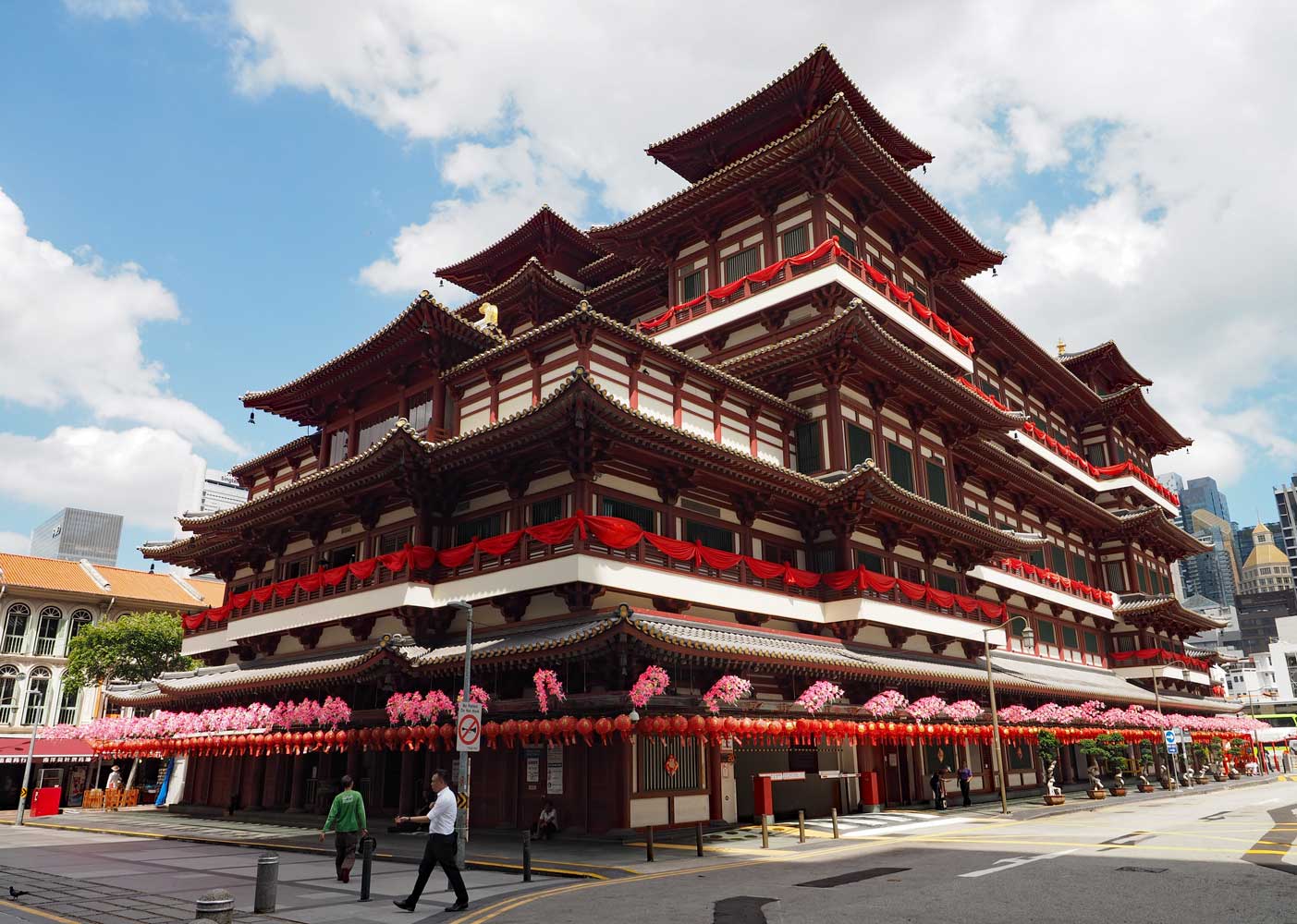
Lanterns encircle the Buddhist Tooth Relic Temple
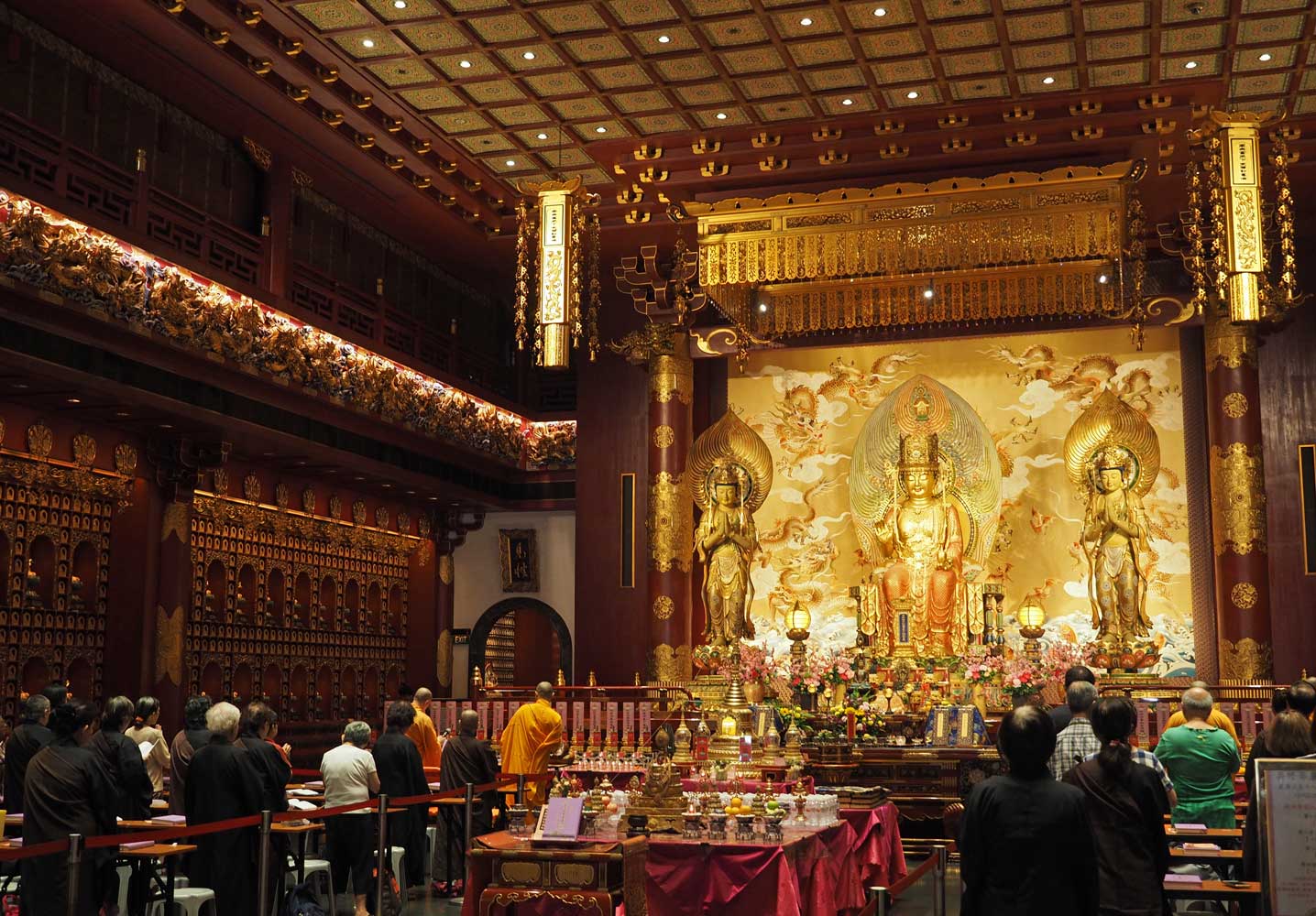
A ceremony in Maitreya Hall

Avalokitesvara radiates compassion in the Universal Wisdom Hall.

Ceiling lanterns of the Universal Wisdom Hall
A few blocks away I turned into the Chinatown Heritage Centre www.chinatownheritagecentre.com.sg/ to see extensive exhibits in an old shophouse. The high admission of S$18 gave me pause, but the museum turned out to be very well done and included an audio-video guide. The self-guided tour begins with a 1950s-era tailor’s shop, where the tailor, his wife, and apprentices lived and worked; they were very lucky to have their own kitchen, bathroom, and (bucket-system) toilet while other shophouse tenants had to share facilities with many others. Upstairs the exhibits tell of life in cramped cubicles by trades people and others, including a traditional doctor who paid a princely sum for a space with a window where he could advertise his services. Next the museum illustrates stories of what newly arrived immigrants experienced after their extremely uncomfortable sea voyages from provinces in China. The exhibits also relate the dark side of early Chinatown with its secret society crime organizations, near slavery for indentured—an even unlucky non-indentured—arrivals, prostitution, opium addiction, and unsanitary living conditions. Lastly exhibits explain how Chinese associations and the government gradually improved life for the people here. The admission ticket, perhaps out of the centre’s guilt for such a high price, includes either a free curry puff or an egg tart with tea at separate shops; I went with the egg tart and tea at a little bakery. I took a look at a Chinese vegetarian restaurant, but in the end decided to go with Indian cuisine and hopped a subway ride to MTR 1924 (438 Serangoon Rd.) for a ‘Mini Meals’ thali.
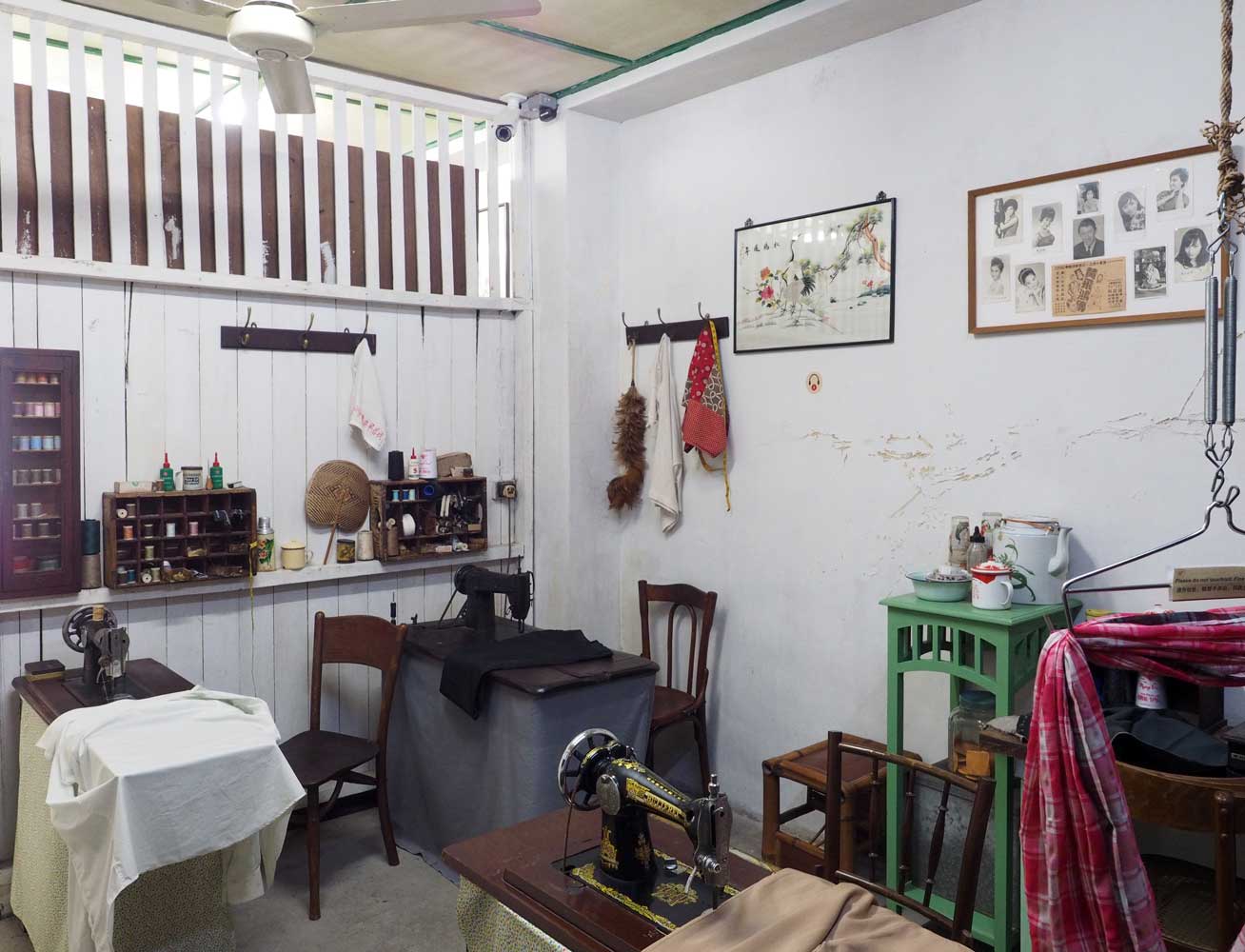
The downstairs tailor shop bustled with activity in the 1950s.
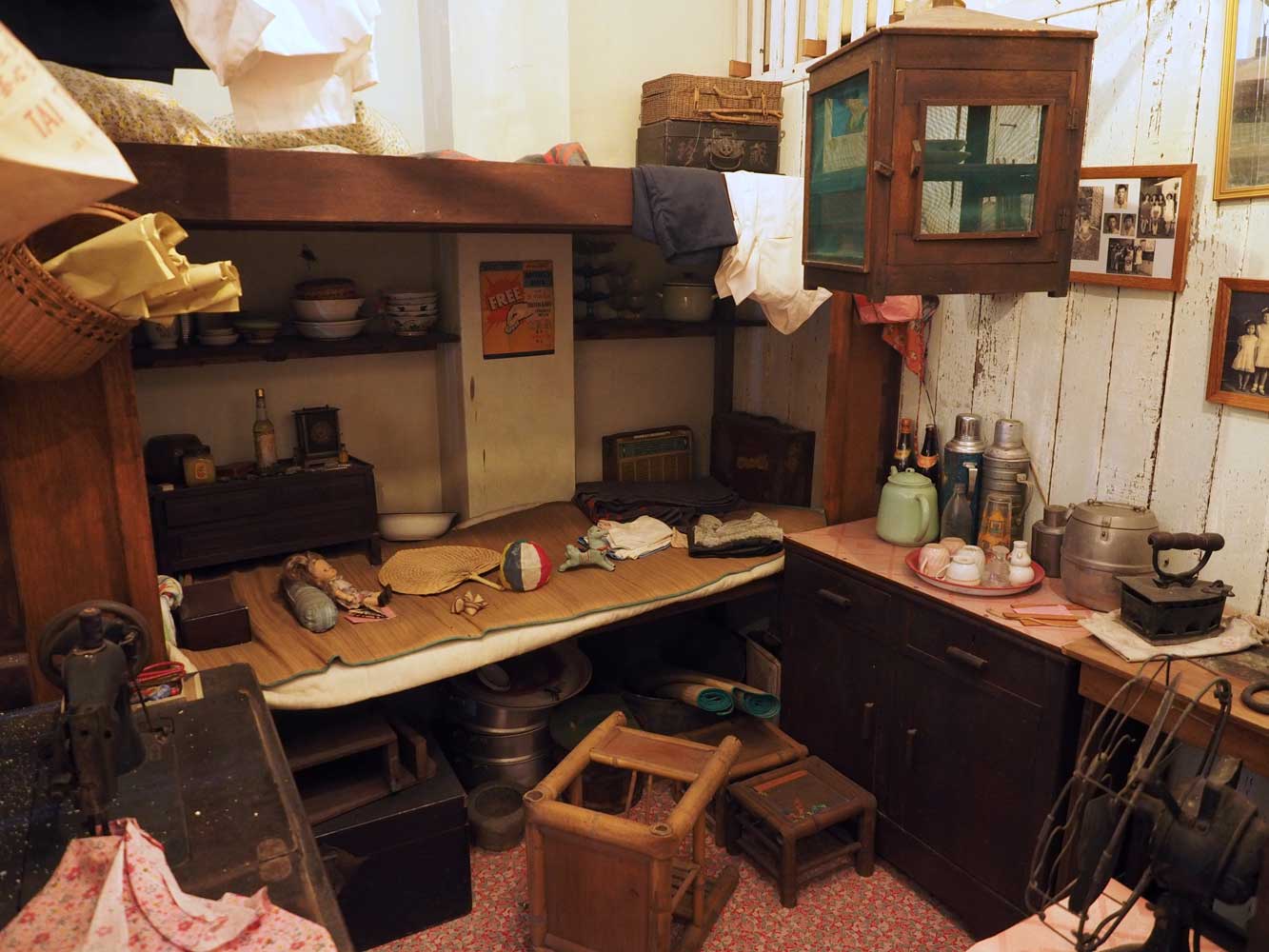
This cubicle housed a family of eight—the factory worker father, seamstress
mother, and their six children!

Chinatown mural detail
27 February Singapore
I
dedicated the morning to laundry—the apartment has a handy washing machine—and
bringing the journal text up to date. On a hot and sunny afternoon I went over
to Kampong Glam, the old Muslim community named after the gelam tree that once
grew here. The Malay Heritage Centre (85 Sultan Gate; S$5 senior)—housed in a
modest istana (palace) completed in 1843 for the last sultan of Singapore—tells
stories about life and personalities here. Boat models cover a wall with the
many types of fishing craft used. Other artifacts and photos show aspects of
home life and Islamic religious practice. Downstairs I enjoyed short clips from
old Malay movies. Afterward I wandered among well preserved shophouses, similar
to those of Chinatown but here occupied by merchants and restaurant owners from
countries such as Lebanon and Turkey. Golden domes and lofty minarets mark the
magnificent Sultan Mosque.
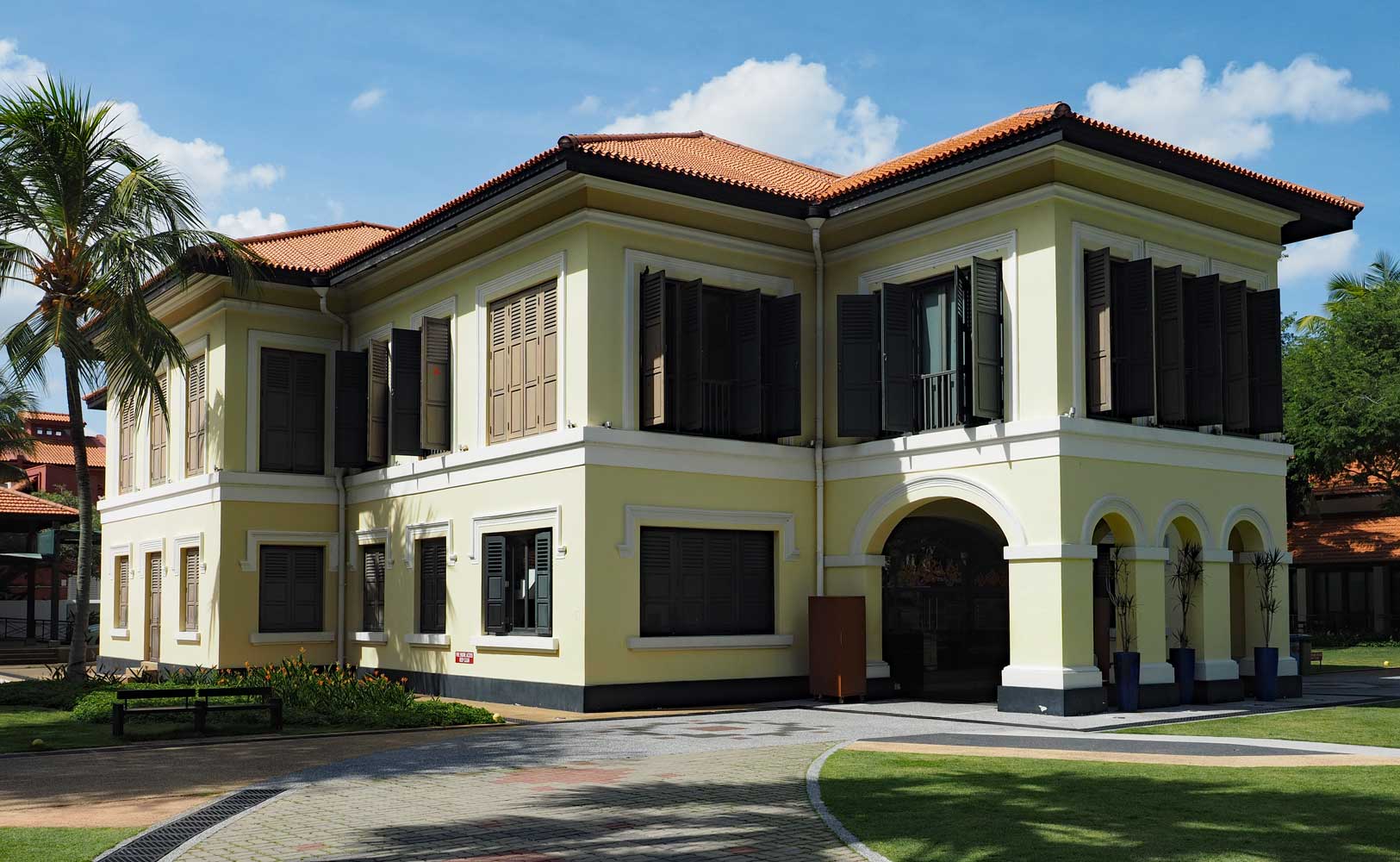
The beautifully restored Malay Heritage Centre
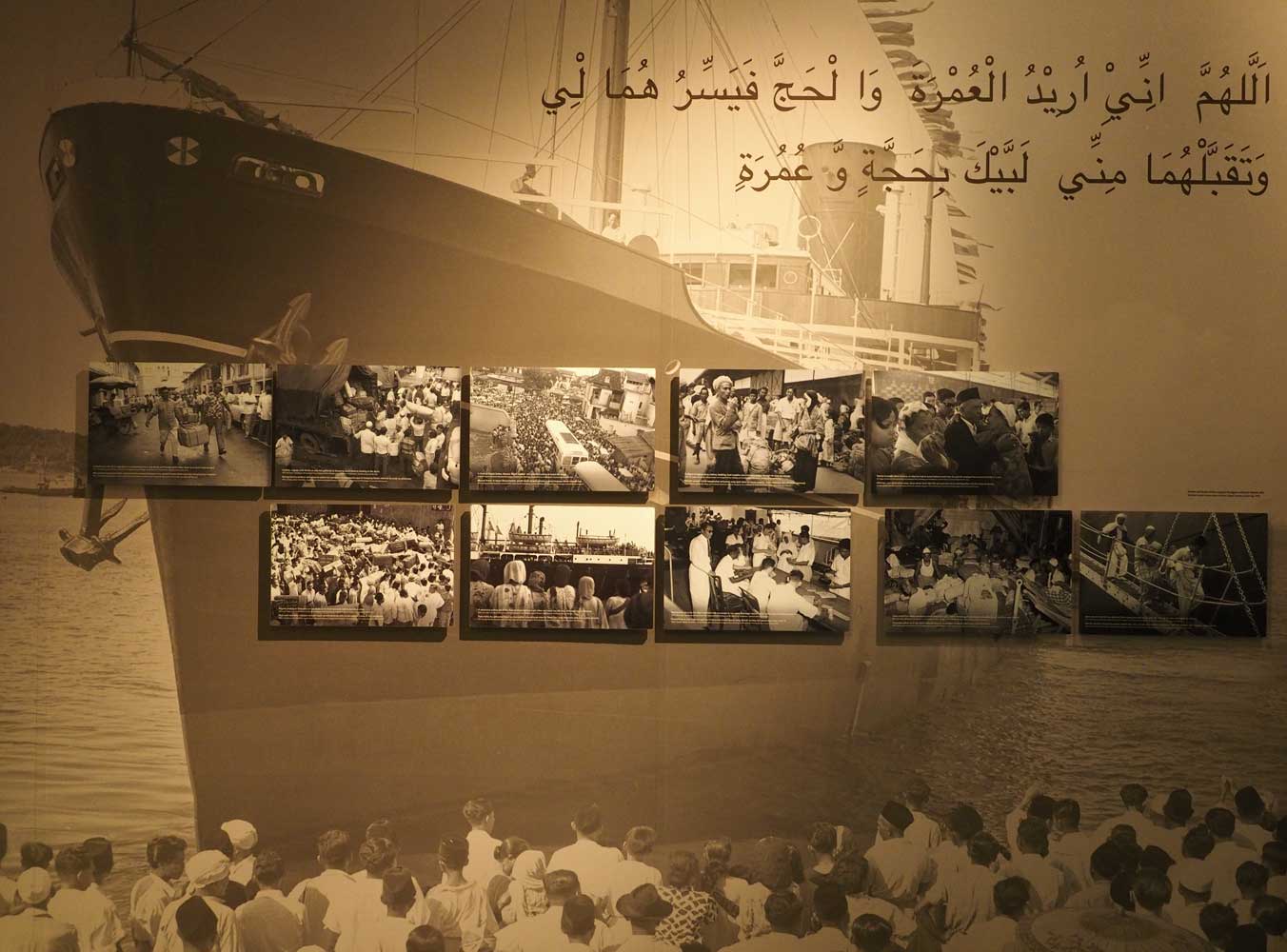
Part of an exhibit that told of the long and difficult journey for pilgrims
to Mecca in the time before air travel

Wayang kulit shadow puppet
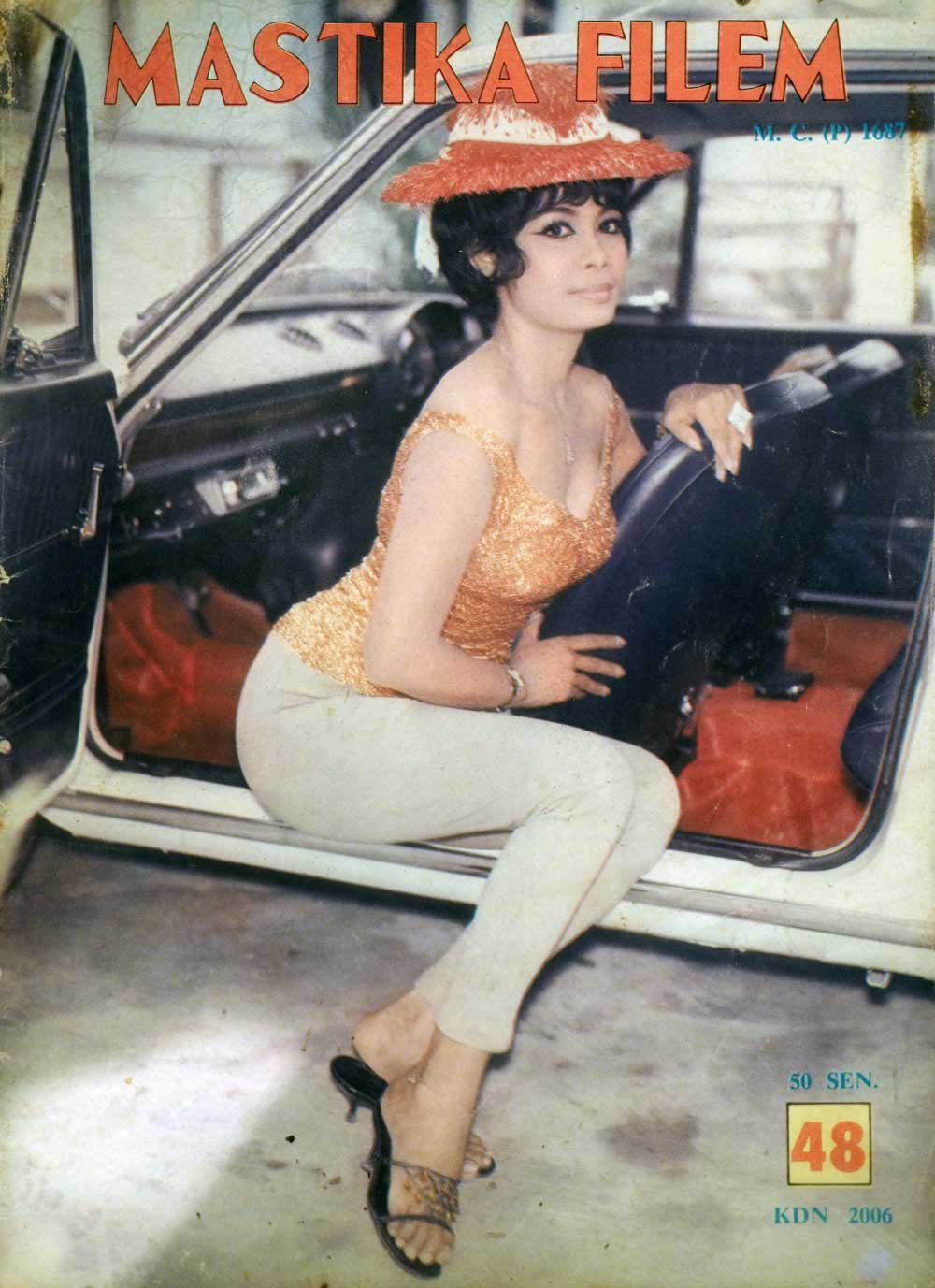
June 1966 issue of Mastika Filem

These restored shophouses could hardly be more colorful!

Tempting sweets!
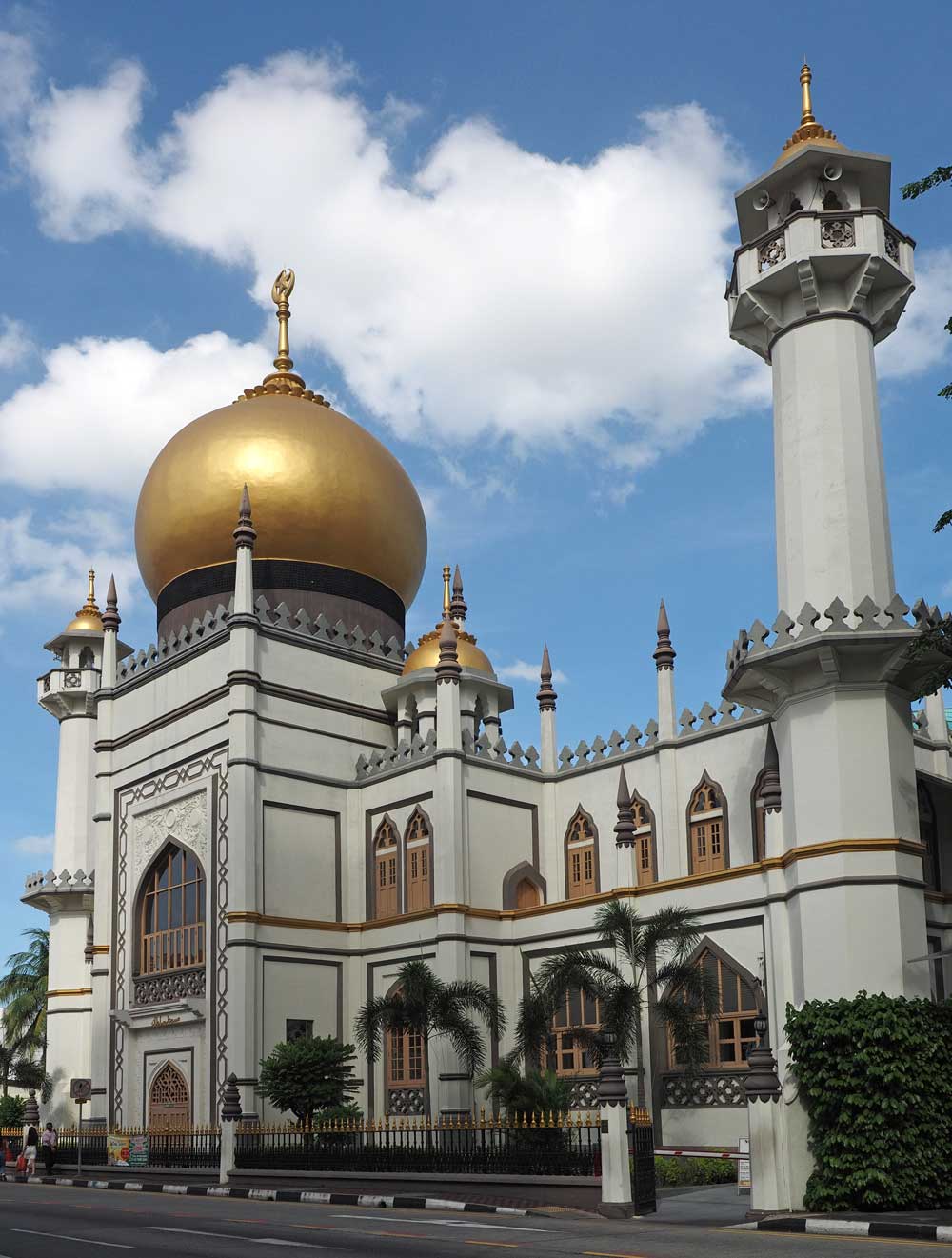
In 1823 the sultan wished to have a mosque close to his residence,
so Sir
Stamford Raffles made provision for a mosque to be built near
the istana and
allocated funds for its construction. By the early 1900s
that structure had become inadequate to serve the community, so
this mosque was commissioned in
1924 with an Indo-Saracenic style.
For dinner I rode a subway two stops northwest to Little India for a last South Indian thali at Komala Vilas Vegetarian Restaurant. Back at my Airbnb room I washed up and did final packing for the flight tonight to the Philippines. At sunset a Grab taxi quickly arrived for the ride to Terminal 4 of Changi Airport. Along the way the driver told me about life in Singapore, currently difficult for his taxi business because tourist levels have decreased dramatically. Unusually the S$500 obtained at an ATM on arrival worked out perfectly with just S$4 left over after I paid the taxi driver and gave him a pocketful of loose coins; I spent the remainder on snacks at a convenience store. My flight to Manila would be on Cebu Pacific, a discount airline with extensive connections between the Philippines and the rest of Asia plus Australia in addition to domestic flights. The check-in for Flight 5J 804, baggage drop, and even immigration have been partially automated now, although a few humans hang around for verification and checking that I had an onward ticket from the Philippines. The departure area is the nicest I’ve ever seen with a variety of comfy chairs and sofas and even live ficus trees. I greatly enjoyed my time in Singapore and hope to return soon, especially as the 11-day visit had been too short to see everything!
On to the Philippines—Part 1: Baguio
Back to beginning of “Backpacking
2020: India, Singapore, and Philippines”